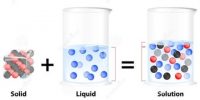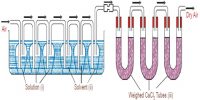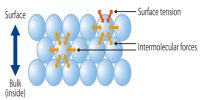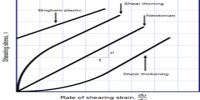The distribution law affirms that a solute gets spread between the two layers of immiscible solvents in such a method that the proportion of its absorption in each solvent becomes equivalent to the proportion of its solubility.
The amount of extracted substance is more if a lesser amount of solvent is used many times relatively than using a larger amount of solvent fewer time.
Applications of Distribution Law
The distribution law can be applied to a number of physical and chemical processes. Thus the association of the solute in one phase can be ascertained, and degree of association and therefore, the molecular mass of the solute in a given liquid can be found out. The law may also be used to determine the degree of dissociation of acids, bases or salts in a solvent. Other examples are given below;
(a) The degree of hydrolysis of substances can be conveniently studied. The hydrolysis of aniline hydrochloride in water can be followed from the distribution of aniline hydrochloride between water and benzene. Thus for this reaction,
Aniline hydrochloride (Salt) + Water (H2O) ↔ Aniline (Base) + Hydrochloric acid (Acid)
Thus, Kh = {[Base] x [Acid]} / {[Salt] x [H2O]}
By applying the principle of equilibrium it can be shown that,
Kh = {C12 (1+vK)} / {C2 – C1(1+vK)}
where C1 is the concentration of the base in aqueous layer (C1 and C2 are expressed in Mol L-1), C2 the original concentration of the salt, K the distribution coefficient and v is the volume of benzene in liters added to 1 liter of water.
(b) The formula of the complex CuSO4.4NH3 was confirmed from the studies of the distribution of ammonia between chloroform and aqueous Copper Sulphate Solution.
(c) Another example of the application of the distribution law can be demonstrated by finding the equilibrium constant for the equilibrium.
Determination of Solubility: The value of K is equal to the ratio of solubility of the solute in the two solvents.
K =C1/C2 = S1/S2
If the value of K and solubility of the solute in one solvent is known then we can calculate the solubility of a solute in other solvents.
Solvent Extraction: Extraction of one substance from a solution containing various substances by using a suitable solvent is known as solvent extraction. “The amount of extracted substance is more if a smaller amount of solvent is used many times rather than using a larger amount of solvent a fewer time”.
Real-life Applications of Distribution law:
- Solvent removal;
- Separation chromatography;
- A release of drug from quantity forms;
- Conservation of emulsions and creams;
- Formation of a solubilized structure.
- One substance can be extracted from the solution containing a variety of substances.
- Used in high act liquid chromatography.
- The solubility of drugs in water and other solvents and in a mixture of solvents can be predicted.
- Structure-activity relationship (SAR) for a series of drugs can be studied.
Limitations of Distribution Law:
Stable temperature: The temperature is kept stable during the experiment.
Same molecular state: The law does not hold if there is an association or dissociation of the solute in one of the solvents. The molecular state of the solute has to stay stable when in make contact with the solvent. It should not endure dissociation or involvement.
Equilibrium concentrations: The concentrations of the solute are noted after the balance has been established.
Dilute solutions: The concentration of the solute in the two solvents is low. The law does not hold when the concentrations are high. The solute that is being dispersed shall not on ant situation imprudent towards the solvents being used.
Among the applications of Nernst’s distribution law, the most significant and attractive one is the extraction of a material dissolved in one solvent by another solvent, the two solvents being partially miscible or immiscible.















